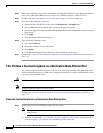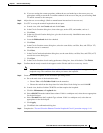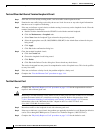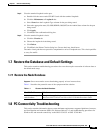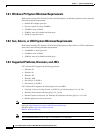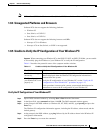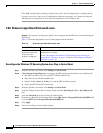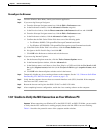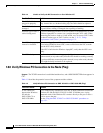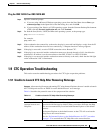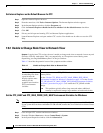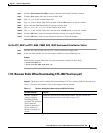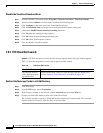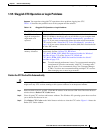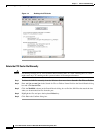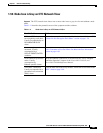
1-50
Cisco ONS 15310-CL and Cisco ONS 15310-MA Troubleshooting Guide, R7.0
Chapter 1 General Troubleshooting
1.8.8 Verify Windows PC Connection to the Node (Ping)
1.8.8 Verify Windows PC Connection to the Node (Ping)
Symptom The TCP/IP connection is established and then lost, and a DISCONNECTED alarm appears in
CTC.
Table 1-5 describes the potential cause of the symptom and the solution.
Table 1-4 Unable to Verify the NIC Connection on Your Windows PC
Possible Problem Solution
The CAT-5 cable is not
plugged in properly.
Confirm that both ends of the cable are properly inserted. If the cable is not
fully inserted due to a broken locking clip, the cable should be replaced.
The CAT-5 cable is
damaged.
Ensure that the cable is in good condition. If in doubt, use a cable known to
be good. Often, cabling is damaged due to pulling or bending.
Incorrect type of CAT-5
cable is being used.
If you are connecting an ONS 15310-CL or ONS 15310-MA directly to your
Windows laptop/PC or a router, use a straight-through CAT-5 cable. When
connecting the node to a hub or a LAN switch, use a crossover CAT-5 cable.
For details on the types of CAT-5 cables, see the “1.11.2.1 Crimp
Replacement LAN Cables” procedure on page 1-71.
The NIC is improperly
inserted or installed.
If you are using a Personal Computer Memory Card International
Association (PCMCIA)-based NIC, remove and reinsert the NIC to make
sure the NIC is fully inserted.
If the NIC is built into the Windows laptop/PC, verify that the NIC is not
faulty.
The NIC is faulty. Confirm that the NIC is working properly. If you have no issues connecting
to the network (or any other node), then the NIC should be working correctly.
If you have difficulty connecting to the network (or any other node), then the
NIC might be faulty and needs to be replaced.
Table 1-5 Verify Windows PC Connection to ONS 15310-CL or ONS 15310-MA (Ping)
Possible Problem Solution
A lost connection
between the Windows
PC and the
ONS 15310-CL or
ONS 15310-MA.
Use a standard ping command to verify the TCP/IP connection between the
Windows PC and the ONS 15310-CL or ONS 15310-MA port. A ping
command works if the Windows PC connects directly to the port or uses a
LAN to access the port.
See the “Ping the ONS 15310-CL or ONS 15310-MA” procedure on
page 1-51.



